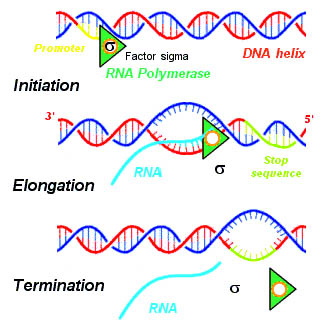explain the process of transcription in eukaryotes with diagram.
Transcription in eukaryotes is a very complex multi-step procedure which involves a number of transcription factors and enzymes. There are three different RNA polymerases found in eukaryotes. These are:
1) RNAP I which synthesizes all ribosomal RNAs (5.8S, 18S, 28S) except for 5S.
2) RNAP II which synthesizes all nuclear genes encoding proteins (mRNAs).
3) RNAP III which synthesizes all tRNAs, the 5S rRNA, and all snRNAs.
The process of eukaryotic transcription is divided into 3 stages:
1) Initiation
During this stage the transcription process is initiated with the help six different transcription factors which guide the binding of RNA polymerase to the promoter region of the gene to be transcribed. This results in unwinding of the DNA to facilitate the working of RNA polymerase. The complex of DNA, RNA pol, and transcription factors is formed which is known as the pre-initiation complex.
2) Elongation
During this stage, RNA polymerase synthesizes the complete RNA from the DNA by addition of nucleotide triphosphates (NTP's) to the growing chain. Most of the transcription factors get dissociated from RNA pol during this phase.
3) Termination
The final step of transcription is the termination of synthesis. As the enzyme, RNA polymerase encounters the transcription end site on the gene, it stops transcription and dissociates from DNA. RNA formed is released from enzyme and further processed to form a complete mRNA.


